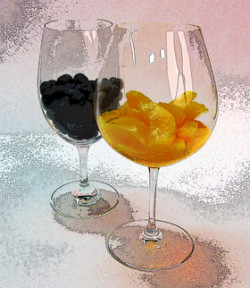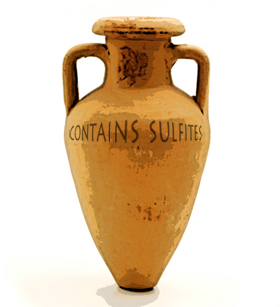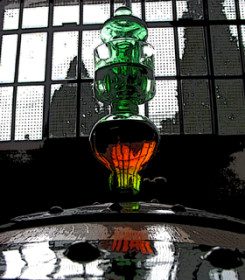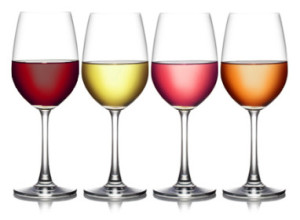Pain & Sulfuring.
Contrary to public opinion, wineries didn’t start adding sulfites to wine in 1987. That’s simply the year the US government dictated all wine containing more than 10 ppm, the smallest detectable amount at the time, be labeled with the warning “contains sulfites.”¹ If a winery can produce wine with less than 10 ppm of detectable sulfites they can forgo the warning label. I’ve sold organic wine for years and only once have I seen a label that read, “contains no detectable sulfites”. It may have been a misprint as the label should have read, “contains no detectable flavor”.
The warning label only applies to wines sold in America, leading many consumers to mistakenly believe that just those bottles destined for America are adulterated with sulfur while their European counterparts remain sulfite-free. The European Union has recently instituted a similar sulfur warning label so the idea that they are sulfite-free should soon be exposed as a myth – just like the idea that vampires can’t go out in daylight (like, have you even seen Twilight?).
Read MoreWild, Cultured or GM; Is Yeast a Fermenting Controversy?
Chapter Twelve. Part Five.
In an effort to tame the temperamental tribulations of fermentation, men have long tinkered with yeast, and as a result, winemakers now have many types of these little critters in their winemaking arsenal. Despite their differences, the one thing that all yeast organisms have figured out is how to convert sugar into alcohol, which is a far greater achievement than anything my college buddies have done with their lives.
Although wild yeast permeates the vineyards and wineries, many winemakers prefer to use cultured yeasts because they come from well-heeled families. Wild yeasts are uncultivated party animals and are therefore less predictable (of course unpredictable can also mean crazy-good). Think of it this way; uncultivated yeasts are like the wine bloggers of the fungi world but not quite as moldy.
Read MoreOf Esters & MLFs.
Chapter Twelve. Parts Three & Four.
The Ester Ouster
 So what makes Cabernet Sauvignon smell like black currants and Viognier smell like peaches? The answer is only skin-deep – much like Jessica Simpson’s appeal or an outbreak of shingles.
So what makes Cabernet Sauvignon smell like black currants and Viognier smell like peaches? The answer is only skin-deep – much like Jessica Simpson’s appeal or an outbreak of shingles.
The cellular make-up of grape skins hold barely detectable aromatic compounds that are magnified during fermentation. Without fermentation these compounds would remain trapped inside the grape skins and then this would be a boring blog about grapes that no one will read … as opposed to a boring blog about wine that no one will read.
The cellular make-up of different grape varieties translates into aromas that are unique to that variety. During fermentation these compounds interact with yeast, alcohol and acids to create flavor substances known as esters. These esters also develop and evolve after fermentation, as chemical reactions continue to take place as wine ages. I also continue to develop new chemical reactions as I age but I control them with Depends.
Read MoreMaceration Makes Me Blush.
(But It Can Also Make Me Red Or White Or Even Orange)
Chapter Twelve. Part Two.
Raise your hand if you think red grapes are filled with red grape juice. Raise your other hand if you think rosé or blush wines are made from pink grape juice. If you have both your hands raised, do the hokey-pokey and turn yourself around because almost all grape juice, whether from white or red grapes, is clear (which is more than I can say about my writing).
As long as I’m straightening out this whole color thing, let me add white grapes are really green, yellow or orange, red grapes are referred to as black but the liquid and skins combine to produce purple juice. Got it? You can put your hands down now.
Years ago when I was studying for a WSET exam I bought a book about fermentation but I found it pretty useless … until I decided to read it. If you want to learn a thing (or two) you’re going to have to click this little read more button…
Read MoreWho Put The Bop In The Bop Shoo-Bop Shoo-Bop?
or “Where Do All Those Wonderful Flavors Come From!”
Chapter Ten. Part One.
 Regular followers of WineSnark have learned how to discern and describe the varied vagaries of vino but have you ever wondered where these peculiarities come from? Why does Syrah from the Rhone Valley taste different from Shiraz produced in Australia? (Syrah and Shiraz are the same grape variety but our spell buds perceive them differently). Where does the “butter” flavor come from in some Chardonnays? How come Cabernet Sauvignon can taste like blackberries or like vanilla? What makes Pinot Noir taste different from Pinot Gris?
Regular followers of WineSnark have learned how to discern and describe the varied vagaries of vino but have you ever wondered where these peculiarities come from? Why does Syrah from the Rhone Valley taste different from Shiraz produced in Australia? (Syrah and Shiraz are the same grape variety but our spell buds perceive them differently). Where does the “butter” flavor come from in some Chardonnays? How come Cabernet Sauvignon can taste like blackberries or like vanilla? What makes Pinot Noir taste different from Pinot Gris?
The answer to these questions can be found in the science of winemaking. Now don’t roll your eyes and reach for the mouse. I realize the onus of this site is flavor and not geography, meteorology, botany or chemistry, but this stuff has everything to do with the quality of wine and it’s about time WineSnark examine the scientific foundation of these unique flavors. I promise to keep it simple and I won’t even use a periodic table, unless I need someplace to set my wine glass.
Read More






















